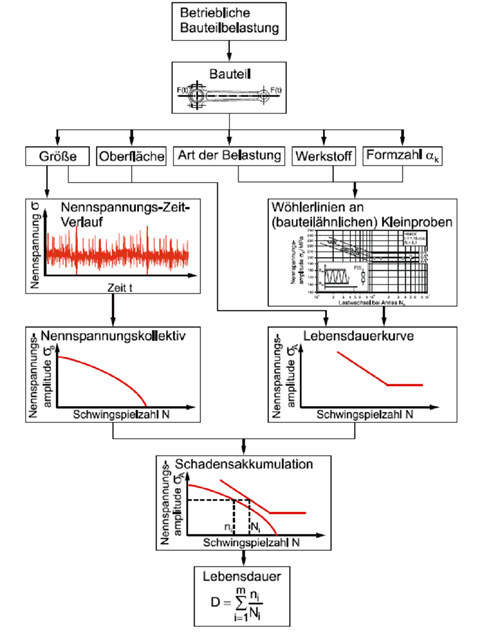CMS of the TB-Möller
Today the Embedded sensor system of the TB-Möller can already supervise the system state constantly and carry out a structural analysis in temporal intervals to guarantee recognizing and avoiding of spontaneously appearing failures from unforeseen or unpredictable state changes like, for example, the fatigue fracture of a highly dynamically loaded wave or structure. It connects in a unique way the experimental modal analysis with the nominal tension draught (figure fig.1) to provide on-line Condition monitoring systems of every kind of structure or system.

Figure fig. 1: Nennspannungskonzept (Quelle: Institut für Materialermüdung, Werkstoffkunde und Festigkeitslehre; www.imwf.uni-stuttgart.de) The figure fig. 2 shows in the upper third a measuring sequence for a loaded mechatronische structure into which the embedded sensor system was integrated. The mechatronic structure was raised with a strength and the amplitude gradually, until the structure was led in a tiredness and finally to the break. Besides, the Sensorik delivered for the purposes of in situ measurement continuously data and the "Dekrement" was filed in a memory. The test time was divided into 5 measuring time intervals. In these intervals it was determined according to the inventive approach the mechanical parameters and was applied - middle partial picture. The lower partial picture shows exemplarily the medium tension change. The course can be described with very good approximation (R ² ≈ 0.98) with an exponential function. The wear of mechatronischen components is shown as a rule as an exponential function. The short crossing between tiredness and break can be determined signal-technically very significantly. For a real use case - for example, like the ice hall collapse in Bad Reichenhall (Germany) from the 2nd of January, 2006 [1] or the break of a wind strength tower in Osthessen (Germany) from the 19th of June, 2011 [2]- the opportunity would have existed to reduce the load on time before the final break. The load would have a damage leave, because it has come possibly to the first sculptural deformations. However, a partial, diminished use of the structure could have been carried out with diminished load group up to a planned exchange of the structure. The embedded sensor system of the TB-Möller can fulfil the demands for modern supervision duties for the purposes of a Condition of monitoring, for the purposes of a Structural Health of monitoring or for the purposes of an active and passive safety with high efficiency.

Figure fig. 2:
Results of the CMS of TB-Möller integrated in a mechatronic structure




